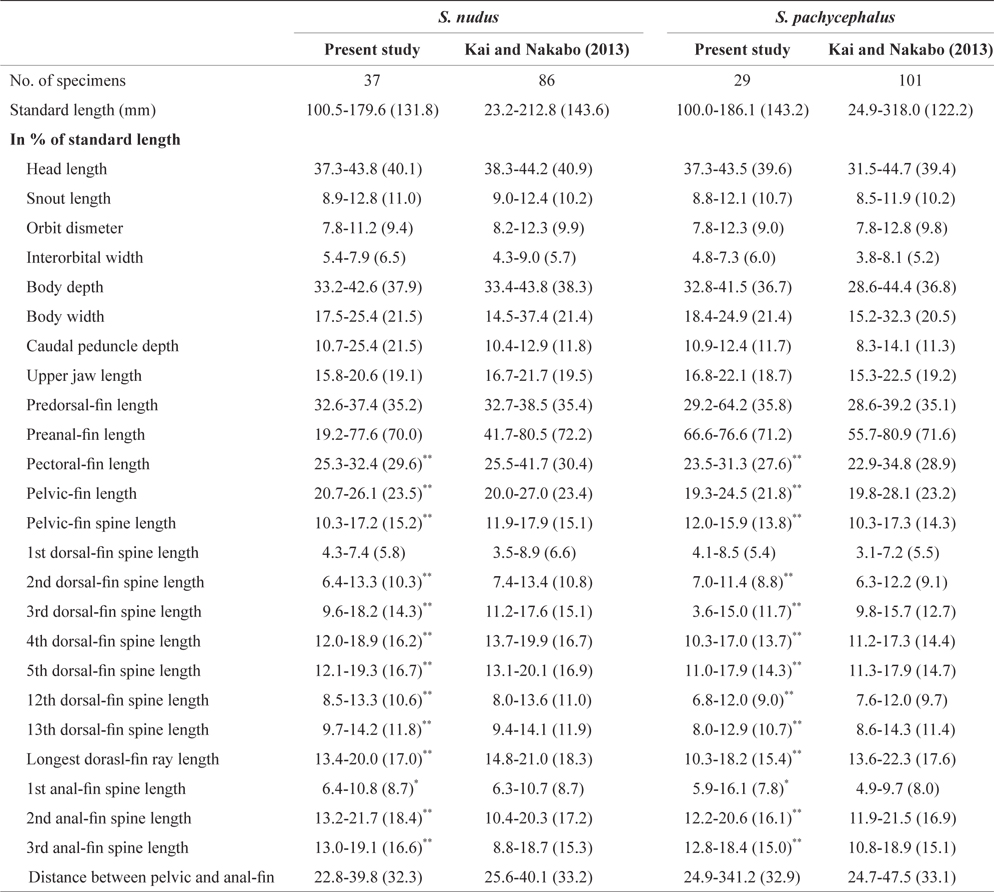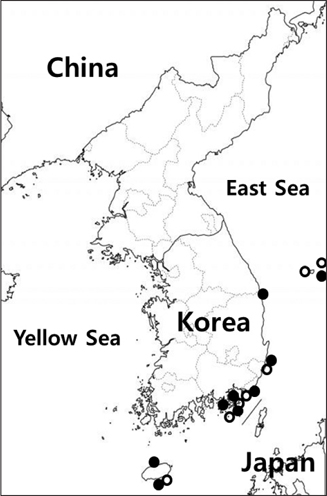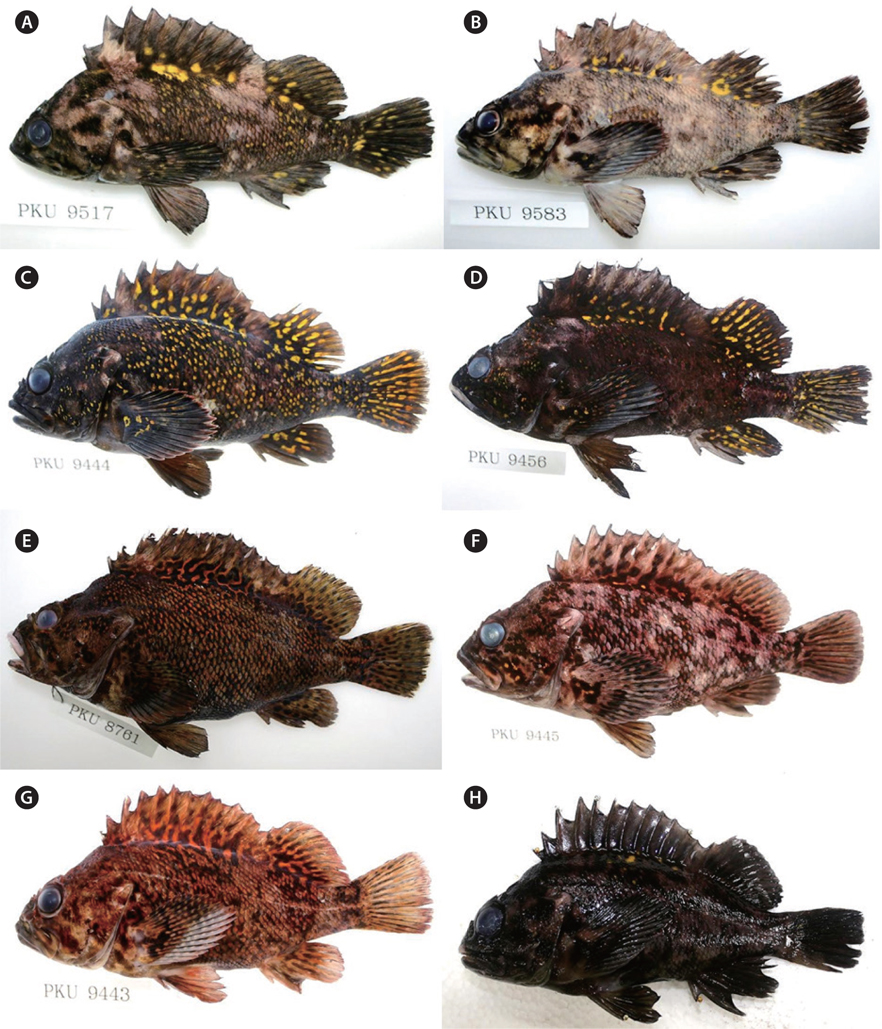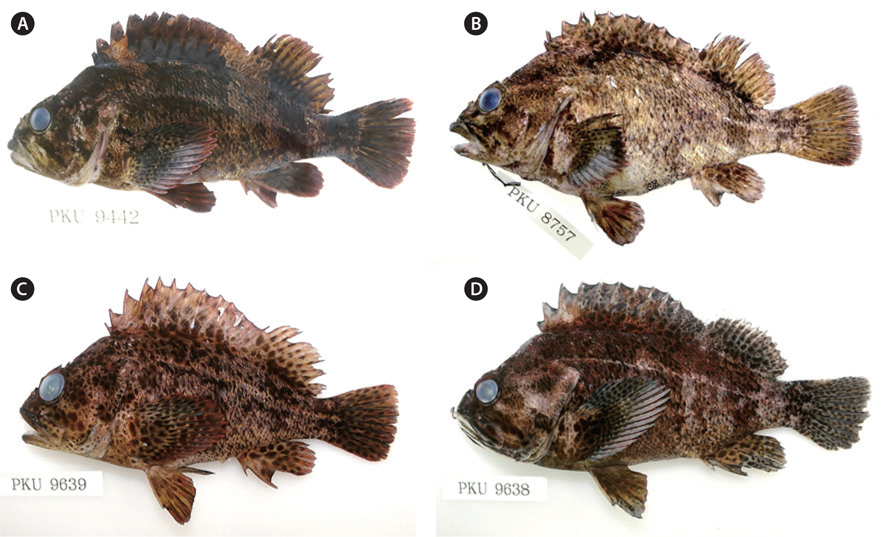



Using the criteria of previous study, we analyzed the morphological characters of 66 specimens of the Sebastes pachycephalus complex collected from Korea between 2008 and 2013. As a result, the 37 specimens were identified as Sebastes nudus, and the remaining specimens as Sebastes pachycephalus. Sebastes nudus is characterized by the absence of scales below the base of the dorsal fin spines; the absence of dark spots on the dorsal, anal, and caudal fins; and the presence of distinct yellow or brownish-red markings on the dorsum (when fresh). The most similar species S. pachycephalus differs from S. nudus in having minute scales below the base of the dorsal fin spines. We propose the new Korean name “Hwang-jeom-gae-bol-rak” for S. nudus, and redescribe S. pachycephalus.
A total of 66 specimens of
>
Sebastes nudus
(new Korean name: Hwang-jeom-gae-bol-rak) (Table 1, Fig. 2)
Sebastes (Murasoius) pachycephalus, form. nudus: Matsubara 1943: 239 (type locality: Hakodate, Hokkaido, Japan and Busan, Korea).Sebastes (Murasoius) pachycephalus, form. chalcogrammus: Matsubara 1943: 244 (type locality: Shimonoseki, Japan).Sebastes pachycephalus nudus: Matsubara, 1955: 1077; Nakabo, 2002: 595.Sebastes pachycephalus chalcogrammus: Matsubara, 1955: 1077; Nakabo, 2002: 595.Sebastes pachycephalus (not of Temminck & Schlegel): Kim et al., 2005: 222.Sebastes pachycephalus complex “species Nu-C”: Kai et al., 2011: 333.Sebastes nudus: Kai and Nakabo, 2013: 551.
[Table 1.] Comparison of counts of Sebastes nudus among present study and others

Comparison of counts of Sebastes nudus among present study and others
Thirty seven specimens, 100.5-179.6 mm in standard length (SL); NIBR P22474, 1 specimen, 170.4 mm SL, Tongyeong, Gyeongsangnam-do, Korea, 18 Jun 2013; PKU 208, 210-216, 8 specimens, 100.5-119.3 mm SL, Tongyeong, Gyeongsangnam-do, Korea, 22 Jul 2008; PKU 1585, 1 specimen, 128.4 mm SL, Udupo, Goseong, Gyeongsangnam-do, Korea, 25 Feb 2009; PKU 2006, 1 specimen, 115.7 mm SL, Geoje-do, Gyeongsangnam-do, Korea, 29 May 2009; PKU 2051, 1 specimen, 121.04 mm SL, Saeng-do, Busan, Korea, 31 May 2009; PKU 2090-2091, 2135, 2137-2138, 5 specimens, 121.6-136.6mm SL, Geoje-do, Gyeongsangnam-do, Korea, 11 Jun 2009; PKU 3404, 1 specimen, 153.2 mm SL, Seogwipo-si, Jeju-do, Korea, 4 Feb 2010; PKU 4045, 4047, 2 specimens, 133.1-163.1 mm SL, Uljin, Gyeongsangbuk-do, Korea, 22 Jun 2010; PKU 6174, 6192, 2 specimens, 153.4-179.6 mm SL, Dok-do, Gyeongsangbuk-do, Korea, 28 Aug 2011; PKU 8759-8761, 3 specimens, 133.6-162.3 mm SL, Geoje-do, Gyeongsangnam-do, Korea, 12 May 2013; PKU 9443-9444, 2 specimens, 132.3-141.3 mm SL, Jeongja-dong, Ulsan, Korea, 19 Jul 2013; PKU 9445, 1 specimen, 163.2 mm SL, Jeju-si, Jeju-do, Korea, 15 Jun 2013; PKU 9456, 1 specimen, 149.7 mm SL, Tongyeong, Gyeongsangnam-do, Korea, 18 Jun 2013; PKU 9458-9461, 4 specimens, 117.1-142.6 mm SL, Geoje-do, Gyeongsangnam-do, Korea, 25 May 2013; PKU 9462, 1 specimen, 120.3 mm SL, Tongyeong, Gyeongsangnam-do, Korea, 31 May 2013; PKU 9517, 1 specimen, 126.5 mm SL, Saengdo, Busan, Korea, 24 Jul 2013; PKU 9582-9583, 2 specimens, 116.2-125.4 mm SL, Ulsan, Korea, 5 Aug 2013.
D. X III, 11-14; A. III, 6; P1. 16-18; P2. I, 5; LLp. 29-33. Counts and measurements are shown in Tables 1 and 2.
[Table 2.] Comparison of measurements between Sebastes nudus and S. pachycephalus

Comparison of measurements between Sebastes nudus and S. pachycephalus
Body relatively deep, moderately compressed, steeply inclined from snout to origin of the dorsal fin (Fig. 2). Mouth large and slightly oblique upward. Posterior margin of the maxilla reaching to the posterior margin of the orbit. Head large and completely covered with ctenoid scales, except for the tip of the snout, maxillary, lacrimal, lower jaw, interopercle, and branchiostegal membranes. Eye relatively large and round. Interorbital region concave and covered with scales. A single pair of nostril presents in front of eye. Strong spines well developed in the head: nasal spine simple, sharp, directed dorsally; preocular spine robust, well developed; supraocular spine robust, well developed, tip of spine reaching or extending beyond the posterior margin of the orbit; postocular spines simple, directed dorsoposteriorly; parietal spine well developed; suborbital without spine or ridge; lacrimal with round lobe anteriorly and one spine posteriorly, the spine sharp, directed dorsally; preopercle with five spines, first and second spines large, well developed, directed posteriorly, fourth and fifth spines small, blunt, directed ventroposteriorly; opercle with two sharp spines, directed posteriorly, upper spine somewhat larger than lower spine. Body covered with ctenoid scales, except for the pectoral fin base, prepelvic region and ventral abdominal region. Pectoral fin base, prepelvic region and ventral abdominal region covered with cycloid scales, ventral abdominal usually surface with narrow naked area anteriorly. No minute scales below the base of the entire spinous portion of the dorsal fin, but sometimes with minute scales below the first to fifth spines or variously to posteriormost spine (Fig. 3). First dorsal spine short, fifth spine longest, last spine longer than the penultimate spine. All dorsal soft rays branched, entire margin rounded. Caudal fin slightly convex but close to truncate. Pectoral fin rounded, not reaching posteriorly to the anus. Second anal spine robust, longest.
East Sea, Korean Strait, and Jeju Island in Korea (present study), Japan (from southern Hokkaido southward along the Pacific coast of Japan to Kanagawa, the east coast of Japan to northern Kyushu Island, Seto Inland Sea) (Kai and Nakabo, 2013), and China (Bohai and Yellow Sea) (Kai and Nakabo, 2013).
The present specimens were identified as

Comparison of the frequency of number of pectoral fin rays between S. nudus and S. pachycephalus
>
Sebastes pachycephalus
(Korean name: gae-bol-rak) (Table 4, Fig. 4)
Sebastes pachycephalus Temminck & Schlegel 1843: 47 (type locality: Nagasaki, Japan).Sebastes (Murasoius) pachycephalus, form. pachycephalus: Matsubara 1943: 239 (Chiba, Kanagawa, Aichi, Wakayama, and Kobe, Japan).Sebastes (Murasoius) pachycephalus, form. nigricans: Matsubara 1943: 242 (Shimonoseki and Nagasaki, Japan).Sebastes pachycephalus pachycephalus: Matsubara, 1955: 1077 (Chiba southward to Kyushu, Japan, Busan, Korea, and China); Chyung, 1977: 500; Nakabo, 2002: 595.Sebastes pachycephalus nigricans: Matsubara, 1955: 1077; Nakabo, 2002: 595.3333Sebastes pachycephalus complex “Species P-Ni”: Kai et al., 2011: 333.Sebastes pachycephalus: Kai and Nakabo, 2013: 542.
[Table 4.] Comparison of counts of Sebastes pachycephalus among present study and others

Comparison of counts of Sebastes pachycephalus among present study and others
Twenty seven specimens, 100.0-186.1 mm in standard length (SL); PKU 200-206, 5 specimens, 100.0-173.8 mm SL, Tongyeong, Gyeongsangnam-do, Korea, 22 Jul 2008; PKU 4046, 4048, 2 specimens, 114.5-186.1 mm SL, Uljin, Gyeongsangbuk-do, Korea, 22 Jun 2010; PKU 5259, 5265, 2 specimens, 142.4-157.6 mm SL, Ulleung, Gyeongsangbuk-do, Korea, 27 Mar 2011; PKU 6168, 6170, 6172-6173, 6178-6180, 6188, 6190-6191, 6195, 6401, 6403, 13 specimens, 118.0-167.8 mm SL, Dok-do, Gyeongsangbuk-do, Korea, 27 Aug 2011; PKU 7094, 1 specimen, 170.1 mm SL, Dok-do, Gyeongsangbuk-do, Korea, 6 Sep 2012; PKU 8756-8757, 2 specimens, 138.9-145.6 mm SL, Geoje-do, Gyeongsangnam-do, Korea, 12 May 2013; PKU 9442, 1 specimen, 129.5 mm SL, Jeongja-dong, Ulsan, Korea, 19 Jul 2013; PKU 9638, 1 specimen, 153.8 mm SL, Dadepo, Bussan, Korea, 2 Jun 2013; PKU 9639-9640, 2 specimens, 137.9-158.8 mm SL, Seogwipo-si, Jeju-do, Korea, 13 Jun 2013.
D. X III, 11-14; A. III, 6; P1. 17-19; P2. I, 5; LLp. 29-33. Counts and measurements are shown in Tables 2 and 4.
Body relatively deep, moderately compressed, steeply inclined from snout to origin of the dorsal fin (Fig. 4). Mouth large and slightly oblique upward. Posterior margin of the maxilla reaching to the posterior margin of the orbit. Head large and completely covered with ctenoid scales, except for the tip of the snout, maxillary, lacrimal, lower jaw, interopercle, and branchiostegal membranes. Eye relatively large and round. Interorbital region concave and covered with scales. A single pair of nostril presents in front of eye. Strong spines well developed in the head: nasal spine simple, sharp, directed dorsally; preocular spine robust, well developed; supraocular spine robust, well developed, tip of spine reaching or extending beyond the posterior margin of the orbit; postocular spines simple, directed dorsoposteriorly; parietal spine well developed; suborbital without spine or ridge; lacrimal with round lobe anteriorly and one spine posteriorly, the spine sharp, directed dorsally; preopercle with five spines, first and second spines large, well developed, directed posteriorly, fourth and fifth spines small, blunt, directed ventroposteriorly; opercle with two sharp spines, directed posteriorly, upper spine somewhat larger than lower spine. Body covered with ctenoid scales, except for the pectoral fin base, prepelvic region and ventral abdominal region. Pectoral fin base, prepelvic region and ventral abdominal region covered with cycloid scales, ventral abdominal surface usually with narrow naked area anteriorly. Base of entire spinous portion of the dorsal fin densely covered with minute scales, usually extending onto basal spines and membranes (Fig. 3). First dorsal spine short, fifth spine longest, last spine longer than the penultimate spine. All dorsal soft rays branched, entire margin rounded. Caudal fin slightly convex but close to truncate. Pectoral fin, rounded, not reaching posteriorly to the anus. Second anal spine robust, longest.
Color variation of
East Sea, Korean Strait, and Jeju Island in Korea (present study), Japan (from Aomori, northern Honshu Island, southward to Kagoshima Bay, southern Kyushu Island) (Kai and Nakabo, 2013), and China (Yellow and Pohai Sea) (Kai and Nakabo, 2013).
In Korea,







